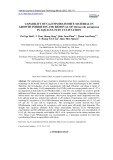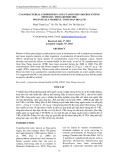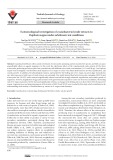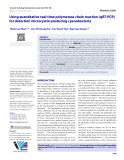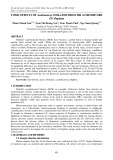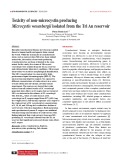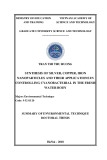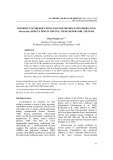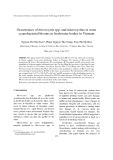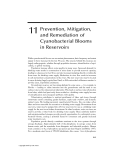
Cyanobacteria bloom
-
This study aimed to investigate the benthic cyanobacterial composition and MC concentration accumulated in sediment from the Tri An Reservoir (TAR), Dong Nai province. Benthic cyanobacterial communities and sediment were collected at five sites in dry and rainy seasons.
 9p
9p  vimulcahy
vimulcahy
 18-09-2023
18-09-2023
 9
9
 3
3
 Download
Download
-
The application of nano materials in disinfection has been considered as a promising technology in the world. However, high cost is one of the main disadvantages of this method. Therefore, the investigation of new nanoparticles with high efficiency and cheap is target of scientists.
 10p
10p  vidudley
vidudley
 20-02-2023
20-02-2023
 3
3
 2
2
 Download
Download
-
Blooms of blue-green algae (cyanobacteria) occur in freshwater as well as marine environments and cause negative impacts to other organisms via production of natural toxins. Microcystins (MCs), producing by many species of cyanobacteria, cause liver damage, cancer, mental disorder and seriously effects on human health.
 10p
10p  vikissinger
vikissinger
 03-03-2022
03-03-2022
 13
13
 1
1
 Download
Download
-
Cyanobacterial blooms often consist of mixtures of microcystin-producing and microcystin-free species, and both can cause unpredictable effects on aquatic organisms. In this work, the subchronic effects of the cyanobacterial crude extracts (CCEs) from microcystin-producing and microcystin-free cyanobacteria with different microcystin concentrations (1, 10, and 50 µgL−1)on Daphnia magna were investigated. The life-history trait responses of D. magna to CCEs were determined based on survival, reproduction, and somatic growth.
 10p
10p  dolomite36
dolomite36
 30-12-2021
30-12-2021
 9
9
 0
0
 Download
Download
-
Results showed that the Microcystis genus dominated the cyanobacterial communities in the TAR. Microcystis was also the primary microcystins (MC) producing cyanobacteria in the water. Total cyanobacteria and Microcystis cells ranged from 152×103 to 27×106 copy/L and from 105×103 to 19×106 copy/L, respectively. The cell number of potentially MC-producing cyanobacteria (corresponding to the Microcystis mcyDgene) varied from 27×103 to 13×106 copy/L.
 8p
8p  spiritedaway36
spiritedaway36
 28-11-2021
28-11-2021
 12
12
 0
0
 Download
Download
-
Harmful cyanobacterial blooms (HCB) have become a global threat to human health and aquatic biota around the world. While the ecotoxicity of microcystins (MC) producing cyanobacteria such as Microcystis spp. has been studied extensively, little is known about toxic effects of others filamentus cyanobacteria such as Anabaena spp. In this study, several strains of Anabaena sp. were isolated from Tri An Reservoir and cultured under laboratory conditions. Microscopic observation was used for morphological identification.
 4p
4p  viwinter2711
viwinter2711
 05-10-2021
05-10-2021
 15
15
 1
1
 Download
Download
-
Harmful cyanobacterial blooms have become a global threat to human health and aquatic biota around the world. While the ecotoxicity of cyanobacterial toxins such as microcystins (MCs) has been studied extensively, the toxicity of non-toxin producing cyanobacteria has not been evaluated to the same extent. In this study, five strains of Microcystis wesenbergii were isolated from the Tri An reservoir and cultured under laboratory conditions. Microscopic observation was used for morphological identification. The MCs concentration was measured by highperformance liquid chromatography (HPLC).
 6p
6p  chauchaungayxua2
chauchaungayxua2
 07-01-2020
07-01-2020
 36
36
 1
1
 Download
Download
-
The objectives of the thesis: Research, fabricate and determine the characteristic of three nanomaterials (silver, copper and iron) and evaluate the ability to inhibit the cyanobacteria of nanomaterials in fresh water bodies.
 27p
27p  xacxuoc4321
xacxuoc4321
 09-07-2019
09-07-2019
 28
28
 4
4
 Download
Download
-
In this study, a 16S rDNA clone library was used to evaluate the diversity of potential microcystin producing cyanobacteria and polymerase chain reaction (PCR) was used to analyze the diversity of this population based on the presence of the mcyD gene in samples collected during a bloom season. The results revealed that Microcystis genera from the Dau Tieng reservoir (DTR) contained several genotypes. The isolated Microcystis strains from the DTR were found to consist both toxic and non-toxic species within species and population.
 10p
10p  shiwo_ding7
shiwo_ding7
 05-06-2019
05-06-2019
 11
11
 0
0
 Download
Download
-
Applying much more phosphorus fertilizer and manure than crops can use builds up phosphorus in soil. After continuous over-fertilization, agricultural fields become a persistent reservoir for phosphorus that ends up polluting water bodies. Recent USGS study found that in the agricultural Midwest, many streams have their highest nitrogen concentrations in the spring, peaking in April-May.
 0p
0p  saimatkhauroi
saimatkhauroi
 01-02-2013
01-02-2013
 43
43
 4
4
 Download
Download
-
Nitrate, the most common form of nitrogen in surface and groundwater, is directly toxic to human health. In- fants who drink water with high nitrate levels can develop an acute, life-threatening blood disorder called blue baby syndrome. high nitrate levels in water can also affect thyroid function in adults and increase the risk of thyroid cancer. Phosphorus stimulates explosive blooms of aquatic algae, including the especially dangerous cyanobacteria (blue-green algae) that produce toxins that can be deadly to pets, livestock, wildlife – and people.
 37p
37p  saimatkhauroi
saimatkhauroi
 01-02-2013
01-02-2013
 29
29
 3
3
 Download
Download
-
This paper reports the analyses of cyanobacteria Microcystis spp. and toxin occurrence in bloom samples from some freshwater bodies in Vietnam. Six species of Microcystis (M. aeruginosa, M. botrys, M. panniformis, M. wessenbergii, M. flos-aquae and M. protocystis) were identified in 8 bloom samples collected from Lake Tri An (Đ ng Nai province), Lake Bien Ho and Lake Duc An (Gia Lai Province), Cua Ngan, Dap Da, Nhu Y, Ho Mung sites (Thua Thien Hue Province), Lake Hoan Kiem (Ha Noi). The results of the quantitative analyses of Microcystis spp.
 6p
6p  tuanlocmuido
tuanlocmuido
 13-12-2012
13-12-2012
 58
58
 5
5
 Download
Download
-
Zubkov et al. (2000) found that Prochlorococcus spp. were the dominant cyanobacteria in the northern and southern Atlantic gyres and the equatorial region, giving way to Synechococcus spp. in cooler waters. Synechococcus cells also become more numerous and even reach blooming densities near the tropical region affected by the Mauritanian upwelling. Finally, the concentrations of Picoeukaryotes tend to be at their height in temperate waters.
 368p
368p  yeutinh98
yeutinh98
 22-09-2012
22-09-2012
 72
72
 9
9
 Download
Download
-
Blooms cyanobacteria trong hồ chứa Trong khi các bông hoa từ cyanobacteria là một hiện tượng cổ đại, tần số và mức độ của họ xuất hiện đã tăng lên trong 50 năm qua. Các lý do đằng sau sự gia tăng này chủ yếu là con người, cho dù thông qua việc gia tăng dân số, tăng cường công tác nông nghiệp, hoặc sự nóng lên toàn cầu. Dân số tăng lên ảnh hưởng đến chất lượng nước bằng nhiều cách. Gia tăng nhu cầu uống nước trong xây dựng các đập nước để cung cấp công suất hồ chứa,...
 23p
23p  hoakimthienduong
hoakimthienduong
 19-12-2011
19-12-2011
 68
68
 5
5
 Download
Download
CHỦ ĐỀ BẠN MUỐN TÌM









